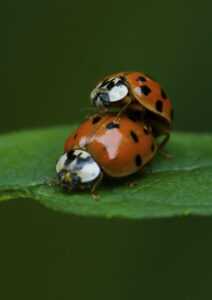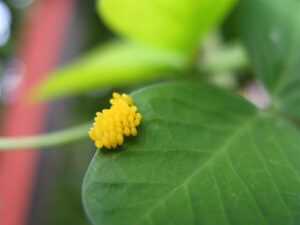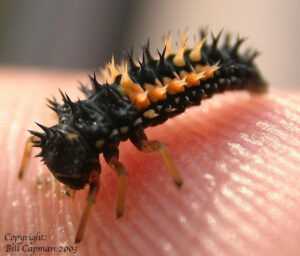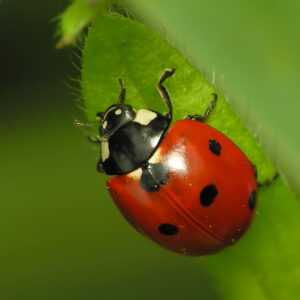Reminder: To order Yiftah’s bi-weekly baked sprouted bread, please let me know by this Friday, June 18th. For an English-language description of Yiftah Bread, click here.
___________________________ Ladybird, ladybird, fly away home Your house is on fire and your children are gone All except one, and that’s Little Anne For she has crept under the warming pan.Last week my Shachar celebrated her third birthday. As part of the preparations, the family prepared a ladybug (a prop for a play). While I was affixing 7-8 spots on our ladybug’s back, I wondered how we never dedicated a newsletter to the sweet, friendly ladybug, a permanent visitor in our field every spring, who contributes her energy and healthy appetite to our pest control.
And, with perfect timing, during last week’s harvest we discovered that, as every spring, our Swiss chard has been attacked by hundreds of sticky, black aphids. When we discover a bush whose base is blackened by tiny, wet dots, we chop down the entire bush and let it grow anew, in the hope that the new growth will be aphid-free. Guess who helps us out with this cleansing process? The good ladybug (Coccinellidae family), capable of consuming some 6,000 aphids in her two to three-year lifespan! She definitely deserves a newsletter, don’t you think?
The Coccinellidae is a very intricate family, with 4,500 species. In Israel, approximately 70 of them are common, the most famous being the seven-spot ladybird (or Ladybug, in American English), said to symbolise seven joys and seven sorrows– or because she has seven spots on her back. Really she has eight, four on each wing, but when her wings are closed, the two central dots connect and look like one dot. But the Coccinellidae family has many varied ladybugs (or beetles) in many different colors and styles.
Both the male and female seven-spot ladybugs are very clearly sexually defined. They do resemble each other a great deal, although the male are quite a bit smaller than the females. It all starts in springtime, when love is in the air, and the females secrete pheromone in order to attract the males (each beetle has a unique pheromone). When they arrive, the coupling occurs (rated X):
This encounter results in a little bundle of yellow eggs (some lay two eggs, while others can lay 400 at once!). Mama ladybug wisely lays them on the lower part of the leaves, where food is available (i.e., aphids, scales, mites and other insect eggs):
After two to five days, black and orange larvae hatch from the eggs:
These larvae immediately start gobbling the aphids around them. Over the next two to three weeks, they will eat some 400 aphids and shed their skin several times to allow their growing body to expand. After three weeks, they will position themselves on a leaf, cling to it, and pupate.
One week later, the ladybug bursts forth. At first, it will be somewhat pale, pinker than red, with faded spots. Only after 24 hours will the color grow redder and the spots on her back appear sharper and lighter, as she turns into the ladybug we know and love.
This process is termed Endopterygota (full metamorphosis) or Holometabola, and it occurs several times yearly with the seven-spot ladybugs.
Our seven-spotters don’t like heat waves, and when the great summer heat begins, they emigrate to higher spots (Mt. Hermon and other tall peaks) to spend the summer in huge communes– mostly windborne, as their flying skills are rather clumsy. During wintertime they hibernate, hardly moving under 12-13 degrees, spending the cold winter seasons slumbering under rocks, and returning to the lower spots the following spring.
Sometimes it is recommended for aphid-infested gardens to buy ladybugs and scatter them around, as a form of biological pest control. This is, of course, somewhat problematic, specifically during summertime, as ladybugs simply won’t stay in a place that is too hot for them– even if offered all-the-aphids-they-can-eat. They’ll just fly away. Nonetheless, in order to attract them to your garden, you can grow some of their favorite plants: Umbels (umbrella-like flowers) like fennel, dill, caraway, angelica, wild carrot and achillea; as well as white cosmos, scented geranium and dandelions. If you do decide to scatter ladybugs in your garden, cool them down in your fridge for one day, wet the plants where you intend to scatter them, and set them out during the evening or very early in the morning. And of course, if you have scattered ladybugs, do not spray your garden with pesticides that will hurt the good insects, among them, our friend.
And what is the origin of the silly Hebrew name for the insect, פרת משה רבנו (“Our Rabbi Moses’ Cow”)? The Hebrew term, like many things from the funny/sacred realm, comes from Yiddish, as a direct translation of the Litvak Yiddish Moshe Rabbenu’s Kiahleh, i.e. “Moshe Rabbenu’s little cow.” (Galitzianers called it Moshe Rabbenu’s Perdeleh, i.e. “Moshe Rabbenu’s pony.”)
Since we’re into our Yiddish mode, every answer begs a question: If we now understand how the innocent beetle got her Hebrew name, why did the European Jews call it “Moshe Rabbenu’s kiahleh/perdeleh” in the first place?
Well… in English the Ladybeetle or Ladybird or Ladybug originated in the Middle Ages when the insects were known as the “beetle of Our Lady,” after The Virgin Mary, who in early religious paintings was often depicted wearing a red cloak. Common names in other European languages have the same association (the German name Marienkäfer translates to “Marybeetle” or ladybeetle), in French, it is the animal of the good God (la bête a bon Dieu) and in Spanish, the little cow of the Lord (vaquilla de Dios). In Russian, too, she is the little cow of the Lord (Божья коровка) and in Serb “Beetle Mary” (bubamara). The Yiddisheh solution to make her “one of ours” was to honor our revered Moses instead!
And the ladybug is divine not only in name. In most cultures, she is thought to bring good luck, and to be protected by the Lord. How did the little ladybug get this honor? Part of the answer came when villagers and farmers noticed that most of the animals and birds do not hurt the tiny ladybug (relatively speaking, of course. Among her enemies are insect-gobbling birds and other predator insects.) The reason for this is a sophisticated deterrent system of deception and protection: first, her bright red color and black dots on her back work well to put off potential enemies, as in the natural world those colors largely symbolize poison. In addition, in times of danger, she has a special deception technique: Her body stiffens, she becomes stationary, and she plays dead until the threat passes. When this is not convincing enough, the ladybug can actually spray from her backside a yellow secretion, rather disgusting in taste and smell (if you’re a bird, of course).
This special protection convinced some people that divine forces must shield the little ladybug. Its healthy appetite, so beneficial for the protection of agricultural crops from fatal aphid attacks, contributed to the feeling that this tiny one has super powers and a direct line to the occult. Some believe that if a ladybug lands on your hand, all sorrow and trouble will disappear with her as she spreads her wings and flies away. You’d better make a wish and notice the direction in which she flew, for that will be from where your good luck will arrive. If you’re a young woman and a ladybug crawls on your hand, you will be married within the year. And if you and he chanced to notice the same ladybug at the same time, love will grow and blossom between you.
There is something special about them. I remember how excited I got the first time I saw the ladybug at work in Chubeza. We had many aphids in our cauliflower at the time, and our advisor, Rafi, counseled us on various substances we could employ to cleanse them of the black insects. I never even got around to acquiring them. When I examined the cauliflower a week later, I was surprised and delighted to discover they were clean. The ladybugs in the area had enjoyed a grand feast! We still see many ladybugs in our field during this season, but we’re feeling their departure as summer approaches. As they bid their farewells, we salute them, sending our best wishes for a cool summer in the high mountains, and a safe return next spring.
Warm regards from Alon, Bat Ami, the Chubeza staff, and our ladybug support team
_____________________________________________
This week’s basket includes:
Monday: cucumbers, fakus, zuchhini, corn, potatoes, basil, tomatoes, parsley, leek, lettuce, carrots, green beans / green cowpea.
In the large box, in addition: Swiss chard, beets, acorn squash
Wednesday: zuchhini, mint, tomatoes, corn, beets, potatoes, lettuce, watermelon, basil, fakus, green beans / green cowpea.
In the large box, in addition: acorn squash, Swiss chard, cucumbers.
__________________________________-
This week we welcome the acorn squashes – here’s a simple basic recipe: Classic Baked Acorn Squash
In honor of last week’s fresh cowpea (that some of you receive now every week): Jamie Oliver’s good old French bean salad
And for our old friends’ sake: Zucchini pate




